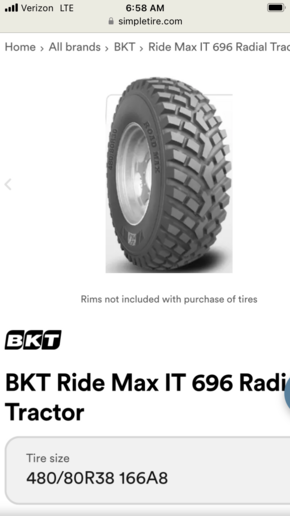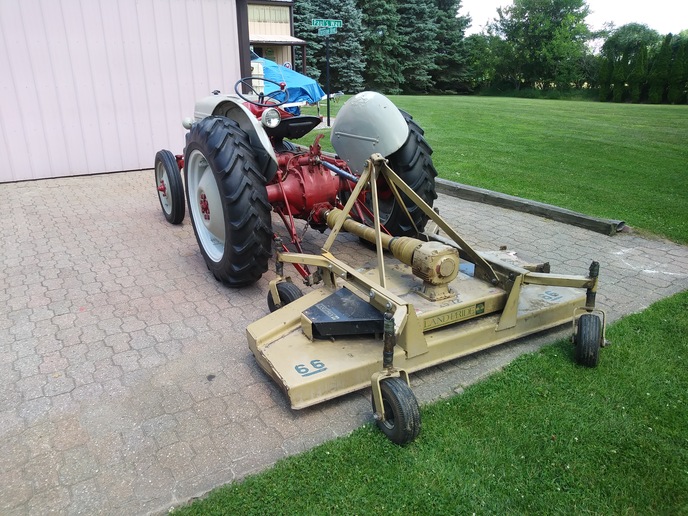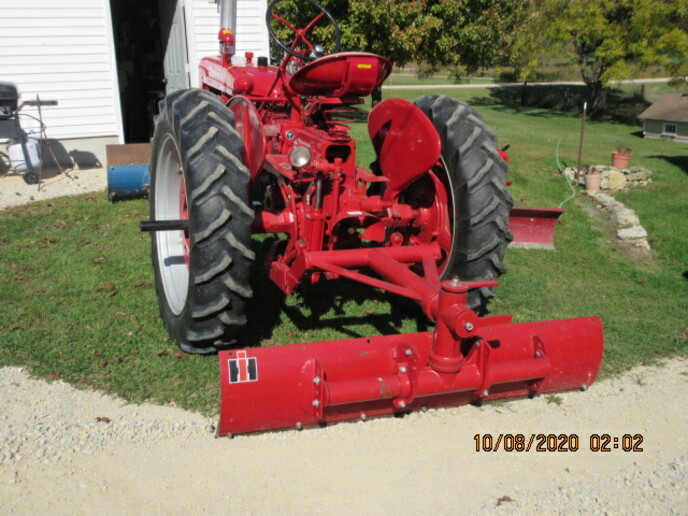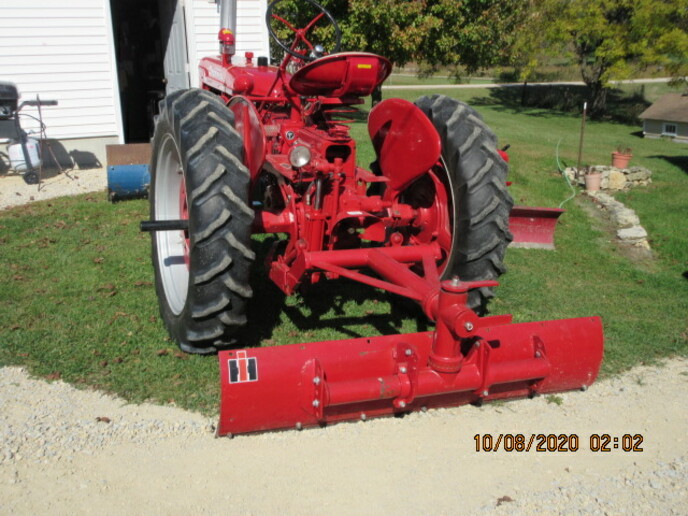It seems tractor tread design has been the same since the steam tractor days. Every other aspect of tractors has been improved, from operator comfort, climate control, fuel types, efficiency, guidance, safety, you name it. Yet with a few exceptions pretty much every tractor new and old comes with the same tires. Has tread design been overlooked or did the guys 100 years ago just happen to get it right on basically the first try? And if the typical chevron design is in fact superior why don't more wheeled machines such as utv's, atv's, or anything else intended for dirt come with them?
You are using an out of date browser. It may not display this or other websites correctly.
You should upgrade or use an alternative browser.
You should upgrade or use an alternative browser.
- Thread starter JDIH
- Start date
Good question. They had the zig zag design
at one time, then pretty much everyone had
the 45 degree V tread until the 23 degree
came about. Then there was some
disagreement between 23 and 45 degree and
long bar/long bar vs. long bar/short bar.
Other than a few small variations, they
haven't changed alot. There are now
radials, but still same basic treads.
Maybe nothing has been proven as a better
compromise between traction and ability to
withstand the torque requirements of a
tractor tire? IDK...not an answer but all
I have!
at one time, then pretty much everyone had
the 45 degree V tread until the 23 degree
came about. Then there was some
disagreement between 23 and 45 degree and
long bar/long bar vs. long bar/short bar.
Other than a few small variations, they
haven't changed alot. There are now
radials, but still same basic treads.
Maybe nothing has been proven as a better
compromise between traction and ability to
withstand the torque requirements of a
tractor tire? IDK...not an answer but all
I have!
Kansas4010
Well-known Member
Atv's go through dirt, mud, sand, pavement
and probably a 100 other surfaces. Each
would require a different designed tire
depending on the driver's use. Also
companies can't sell the exact same tread
design as a different company. Besides
that how many people do you know can agree
on the superiority of just one tire. If
that's the case why does someone post on
here at least once a month about opinions
on which tractor tires to buy.
and probably a 100 other surfaces. Each
would require a different designed tire
depending on the driver's use. Also
companies can't sell the exact same tread
design as a different company. Besides
that how many people do you know can agree
on the superiority of just one tire. If
that's the case why does someone post on
here at least once a month about opinions
on which tractor tires to buy.
Tim PloughNman Daley RIP
Well-known Member
...It seems tractor tread design has been the same since the steam tractor days... Not true. Tractor and tire engineers had always been working on tread designs.
FORD wanted a universal tread that would work in every soil condition. When the 9N Ford-Ferguson was released in June, 1939, the rear tires had 9 x 32, 45 DEG closed
center bars. The fronts used a 4 x 19 single rib tire. Look at early steel wheels and some also had a single rib. Charles Goodyear discovered Vulcanization by
accident in the 1830's and that changed tire manufacturing forever. Ford used BF Goodrich on the Model A, the first US auto to travel across the USA. Henry Ford and
Harvey Firestone were good buddies, half of part of their Vagabonds group, and both men constantly working on a better tire. In 1940 the rear tire was now 10 x 28 and
still 45 deg closed center bars but by 1941 were changed to 27.5 deg open centers. In July 1947 the new 8N Model was released and now used a closed center bar tread
that had a 23 DEG design. This style was only used for two years, 47-49. In 1950 the design was changed to a 23 DEG open bar design. Steel wheels were used on
tractors since the dawn of man but when rubber was discovered, it was new to everybody, so trial and error was the method used. FORD also had a tire plant at the Rouge
but was soon dismantled and machinery sent the USSR. Besides FORD and FIRESTONE, BF GOODRICH were also a supplier.
FORDSON TRACTOR ON STEEL WHEELS, NOTE SINGLE RIB FRONTS:

EARLY FORD 9N 9 TRACTOR REAR 9 X 32 TIRE w/ 45 deg CLOSED CENTER BAR:

EDSEL FORD DEMONSTRATES PLOWING WITH THE NEW 9N TRACTOR. NOTE- 9 X 32 REARS, w/45 deg CLOSED CENTER BARS, and 4 X 19 SINGLE RIBBED FRONTS:

1940 FORD 10 X 28 REAR TRACTOR TIRE:

FORD/FIRESTONE SPECIAL TREAD USED ON 9N INDUSTRIAL MODELS:
 NOTE: LATER THESE WERE DUBBED 'TURF TIRES', USED ON GOLF COURSES & SUCH
NOTE: LATER THESE WERE DUBBED 'TURF TIRES', USED ON GOLF COURSES & SUCH
FORD-FERGUSON 2N 'WARHORSE' MODEL ON STEEL WHEELS:

1948 FORD 8N TRACTOR w/ REPRODUCTION FIRESTONE CHAMPION 'SPADE GUIDE GRIP' CLOSED long bar BAR CENTERS, USED ONLY 47-49:


MODERN FIRESTONE CHAMPION SPADE GRIP 23 deg BAR:

FORD/FIRESTONE THE 5.50 & 6.00 X 16 FRONT TIRES AS OPTIONS FOR USE WITH FELS, INTRODUCED WITH THE 8N:


MODERN FIRESTONE 11.2 X 28 'FIELD & ROAD' w/23 OPEN CENTER BAR TIRES:

Tim Daley(MI)
FORD wanted a universal tread that would work in every soil condition. When the 9N Ford-Ferguson was released in June, 1939, the rear tires had 9 x 32, 45 DEG closed
center bars. The fronts used a 4 x 19 single rib tire. Look at early steel wheels and some also had a single rib. Charles Goodyear discovered Vulcanization by
accident in the 1830's and that changed tire manufacturing forever. Ford used BF Goodrich on the Model A, the first US auto to travel across the USA. Henry Ford and
Harvey Firestone were good buddies, half of part of their Vagabonds group, and both men constantly working on a better tire. In 1940 the rear tire was now 10 x 28 and
still 45 deg closed center bars but by 1941 were changed to 27.5 deg open centers. In July 1947 the new 8N Model was released and now used a closed center bar tread
that had a 23 DEG design. This style was only used for two years, 47-49. In 1950 the design was changed to a 23 DEG open bar design. Steel wheels were used on
tractors since the dawn of man but when rubber was discovered, it was new to everybody, so trial and error was the method used. FORD also had a tire plant at the Rouge
but was soon dismantled and machinery sent the USSR. Besides FORD and FIRESTONE, BF GOODRICH were also a supplier.
FORDSON TRACTOR ON STEEL WHEELS, NOTE SINGLE RIB FRONTS:

EARLY FORD 9N 9 TRACTOR REAR 9 X 32 TIRE w/ 45 deg CLOSED CENTER BAR:

EDSEL FORD DEMONSTRATES PLOWING WITH THE NEW 9N TRACTOR. NOTE- 9 X 32 REARS, w/45 deg CLOSED CENTER BARS, and 4 X 19 SINGLE RIBBED FRONTS:

1940 FORD 10 X 28 REAR TRACTOR TIRE:

FORD/FIRESTONE SPECIAL TREAD USED ON 9N INDUSTRIAL MODELS:

FORD-FERGUSON 2N 'WARHORSE' MODEL ON STEEL WHEELS:

1948 FORD 8N TRACTOR w/ REPRODUCTION FIRESTONE CHAMPION 'SPADE GUIDE GRIP' CLOSED long bar BAR CENTERS, USED ONLY 47-49:


MODERN FIRESTONE CHAMPION SPADE GRIP 23 deg BAR:

FORD/FIRESTONE THE 5.50 & 6.00 X 16 FRONT TIRES AS OPTIONS FOR USE WITH FELS, INTRODUCED WITH THE 8N:


MODERN FIRESTONE 11.2 X 28 'FIELD & ROAD' w/23 OPEN CENTER BAR TIRES:

Tim Daley(MI)
Bob Bancroft
Well-known Member
- Location
- Aurora NY
I see it differently. While tractor tire treads may all look similar to many people, many little variations have been tried, and
they make a difference. Many are a result of compromises between goals- say of a smooth ride vs traction. And traction in what
conditions? In the 60's it seemed like half of the new tractors came with those 45 degree GoodYear tires. They were hard rubber,
lasted forever, but didn't pull well in our soil when it was damp. The straighter Firestone tread has always done better here. But
how many machines are always involved in a hard pull in sticky soil? The Armstrong/Titan bias tires of the 70's pulled well here,
but were soft rubber, and wore out fast. Plus, if run soft at all, the sidewalls gave out. So, again, the bi-directional, long
bar/short bar, jagged bar, curved bar, and whatever bar, etc, all make a difference, albeit maybe a slight difference in many
circumstances, but an important difference in some situations.
they make a difference. Many are a result of compromises between goals- say of a smooth ride vs traction. And traction in what
conditions? In the 60's it seemed like half of the new tractors came with those 45 degree GoodYear tires. They were hard rubber,
lasted forever, but didn't pull well in our soil when it was damp. The straighter Firestone tread has always done better here. But
how many machines are always involved in a hard pull in sticky soil? The Armstrong/Titan bias tires of the 70's pulled well here,
but were soft rubber, and wore out fast. Plus, if run soft at all, the sidewalls gave out. So, again, the bi-directional, long
bar/short bar, jagged bar, curved bar, and whatever bar, etc, all make a difference, albeit maybe a slight difference in many
circumstances, but an important difference in some situations.
There are several tread patterns on the market right now.
Many more have been tried over the past years. All had
their best uses and didnt work as well in other
conditions.

The straighter the bar, the better the traction properties,
and the worse the ride.
Many more have been tried over the past years. All had
their best uses and didnt work as well in other
conditions.

The straighter the bar, the better the traction properties,
and the worse the ride.
560Dennis
Well-known Member
- Location
- Madison,Ohio
Interested in a 36 inch for my tractor.
560Dennis
Well-known Member
- Location
- Madison,Ohio
No i believe a huge change in tire technology . In 48 we had Firestone 9-36 sure grips. They were terrible. Ten years late we got bf
Goodrich for the tractor . I was shocked how it change that tractor plowing.
The 1960 Goodyears on 560 ,2015 got Firestone for it again ,why the thunder we wait so long !
Money , could not afford the tires till we were force to ,they wore out. But wear and tear on differential axles and bearings cost will make you
switch sooner . Crunch the numbers
Goodrich for the tractor . I was shocked how it change that tractor plowing.
The 1960 Goodyears on 560 ,2015 got Firestone for it again ,why the thunder we wait so long !
Money , could not afford the tires till we were force to ,they wore out. But wear and tear on differential axles and bearings cost will make you
switch sooner . Crunch the numbers
caterpillar guy
Well-known Member
The picture of the BKT in moresmoke's post will ride better and not probably pull as well. If you had a tractor dedicated to a manure tank/spreader that would probably be a good choice since unless it is real muddy you could go well with a decent ride on road travel. The more angle to the lug the less side slide you would have on side hills and of course the straighter the bar the better it would pull on flat ground best idea I have.
Blackhole49
Well-known Member
- Location
- White Lake MI
My contribution.


fastfarmall
Well-known Member
But the field and road came with a warranty at first, if you didn'I like em, we will take em off it said in their advertisment,i know two farmers that made them take them off. But as far as old tires i likes the Firestone All Traction Iires and they said Gum Dipped,they worked in our area,they would clean better than a Good Year!
1948CaseVAI
Well-known Member
Many thanks to Mr. Daley for his fascinating post!
A powered wheel going through dirt needs an angled cleat to,push the soft stuff aside and get a bite on firm stuff.
So the very basic design of an angled bar is going to be best in those situations. They figured that out pretty early
on.
There have been 100s of different patterns from all one angle, to overlapping herringbone bars, to different angle
degrees. They probably all look the same to you, but they are very different and has been an ongoing development
to get to the best tread design.
Complicating it is different needs: what works well on plowed dirt is different than what works best on notill dirt
compared to what works best on alfalfa and hay grass dirt.
Then if you travel on a lot of pavement tire wear is a concern, and you might want a pattern that isnt perfect on dirt
but doesnt wear quite as fast. A compromise.....
Then you need compromises when you do several different things with the same tractor.
So there is room for many different patterns still, and room to develop more.
I have not seen the same perfect tire design for decades? Lots of changes and progress.
Paul
So the very basic design of an angled bar is going to be best in those situations. They figured that out pretty early
on.
There have been 100s of different patterns from all one angle, to overlapping herringbone bars, to different angle
degrees. They probably all look the same to you, but they are very different and has been an ongoing development
to get to the best tread design.
Complicating it is different needs: what works well on plowed dirt is different than what works best on notill dirt
compared to what works best on alfalfa and hay grass dirt.
Then if you travel on a lot of pavement tire wear is a concern, and you might want a pattern that isnt perfect on dirt
but doesnt wear quite as fast. A compromise.....
Then you need compromises when you do several different things with the same tractor.
So there is room for many different patterns still, and room to develop more.
I have not seen the same perfect tire design for decades? Lots of changes and progress.
Paul
Guys, a 45 tread is popular in Europe where they have peat based soil. A 23 is popular here in the states because 90% of out soil is Clay based. They have both been tried here. I had rice and Cain tires on my combine. If I ever get another combine, I will put R&C tires put on it. They will shake, rattle, and roll you on the road but in the field they go well.
BarnyardEngineering
Well-known Member
- Location
- Rochester, NY
It's not as if they haven't tried to improve tractor tread design, but they keep ending up back at the simple 45 degree lug.
First improvement they tried was the 23 degree lug. Then various iterations of long-bar/short-bar. Then the infamous DT710 short-bar/short-bar.
Most the brands have gone back to making a simple 45 degree lugged tire. Turns out the simplest solution is the best solution.
The biggest improvement to tractor tire performance is/was the radial tire.
First improvement they tried was the 23 degree lug. Then various iterations of long-bar/short-bar. Then the infamous DT710 short-bar/short-bar.
Most the brands have gone back to making a simple 45 degree lugged tire. Turns out the simplest solution is the best solution.
The biggest improvement to tractor tire performance is/was the radial tire.
Similar threads
- Replies
- 30
- Views
- 11K
- Replies
- 1
- Views
- 869
We sell tractor parts! We have the parts you need to repair your tractor - the right parts. Our low prices and years of research make us your best choice when you need parts. Shop Online Today.
Copyright © 1997-2024 Yesterday's Tractor Co.
All Rights Reserved. Reproduction of any part of this website, including design and content, without written permission is strictly prohibited. Trade Marks and Trade Names contained and used in this Website are those of others, and are used in this Website in a descriptive sense to refer to the products of others. Use of this Web site constitutes acceptance of our User Agreement and Privacy Policy TRADEMARK DISCLAIMER: Tradenames and Trademarks referred to within Yesterday's Tractor Co. products and within the Yesterday's Tractor Co. websites are the property of their respective trademark holders. None of these trademark holders are affiliated with Yesterday's Tractor Co., our products, or our website nor are we sponsored by them. John Deere and its logos are the registered trademarks of the John Deere Corporation. Agco, Agco Allis, White, Massey Ferguson and their logos are the registered trademarks of AGCO Corporation. Case, Case-IH, Farmall, International Harvester, New Holland and their logos are registered trademarks of CNH Global N.V.
Yesterday's Tractors - Antique Tractor Headquarters
Website Accessibility Policy



